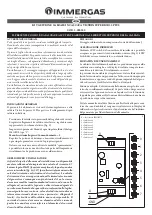
EP E
series
11-03
6
Illustrations may differ from the actual product
Allowing for printing errors and errors on proofs
The installation must comply with the applicable
regulations and standards.
Install the boiler horizontally with vertical pipe connections, allow-
ing air to escape.
The boiler must be installed indoors in a cellar or on the ground
floor.
The ambient temperature must not exceed 30°C.
The applicable regulations state that an installation inspection
must be carried out on a boiler system with an unvented expan-
sion vessel, before it is put into operation. The inspection must
be documented and carried out by a person qualified for the
task. A further inspection is required if the boiler or the expan-
sion vessel is replaced.
The boiler is fitted with adjustable base bolts, which can be
adjusted to level the boiler.
Do not drill into the cover panels of the boiler
– the residues may harm the electronics.
Siting the boiler
The boiler is approved for installation directly on the floor under the
High Current Regulations [Starkströmsföreskrifterna]. Wall brackets
are available as accessories.
Cables and pipework
The cables and pipes must be arranged so it is possible to remove
the front and top covers after installation.
Low current cables must not be laid parallel to high current cables
as induction may affect the signal carried by the low current cables.
Safety/supply pipe
If the safety pipe is not connected to an open expansion vessel, it
is essential for the safety pipe to be equipped with automatic bleed
valve. Otherwise, air can collect at the top of the tank, damaging the
immersion heaters.
The safety pipe to the safety valve or the open expansion vessel is
connected to the supply pipe.
Water quality
Mains water quality is usually classified in terms of its hygiene.
Water that is high quality from the point of view of hygiene is not
necessarily suitable for use in a heating system. To avoid problems,
the water should be analysed from a technical point of view. Any dif-
ferences from standard values should be corrected.
If the volume of the heating system is small, the boiler and heating
system can be filled with water that is not classified as high qual-
ity boiler water. When the water is heated, some of the oxygen and
carbon dioxide is carried to the expansion vessel or to bleed valves.
The rest will react with the metals in the system. This corrosion usu-
ally becomes less important because the same water is circulating,
which quickly loses its oxygen. It is important to make the system
watertight so that no new, oxygen-rich water has to be added, and
to ensure that the water is not oxygenated during installation.
In large systems it is virtually impossible to prevent leaks and oxy-
genation. In such systems, an oxygen-demanding agent can be add-
ed so there is always a slight surplus in the system. These agents
often contain anti-corrosive additives.
Water quality, based on suitable mains water:
The alkalinity should exceed 60 mg/l to avoid corrosion.
Carbon dioxide contents exceeding 25 mg/l increase the risk of cor-
rosion.
Sulphate contents exceeding 100 mg/l may hasten corrosion, and
if the sulphate content is higher than the alkalinity, there is a risk
of copper corrosion.
Hard water produces scale and is not suitable in heating systems.
Very soft water can cause corrosion.
Chloride contents exceeding 100 mg/l make the water aggressive,
especially combined with lime scale.
Low pH values can cause corrosion – the pH value should be be-
tween 7.5 and 8.5.
The occurrence of carbon dioxide combined with a low pH value
and hardness value makes the water aggressive.
Frost protection
If the water is mixed with ethylene glycol, make sure it contains ap-
propriate concentrations of anticorrosive additive. When ethylene
glycol decomposes, one of the by-products is carbon dioxide, which
increases the risk of corrosion.
Flow requirement
The boiler must have a constant and sufficiently strong flow in order
to work properly.
If the flow through the boiler is too slow, the following problems may
be caused:
- The difference between the temperature setting and the actual
temperature achieved in the boiler increases.
- Erratic operation, which increases wear on the boiler contactors,
with a consequent reduction in service life.
If the flow is too fast, the following problems may be caused:
- Vibrations in the immersion heaters, resulting in noise and reduced
service life.
- Unnecessary wear to the system components.
Recommended flow
EP 26 E:
recommended:
0.65 l/sec,
∆
t = 10 °C
min:
0.25 l/sec,
∆
t = 25 °C
max:
2 l/sec,
∆
t = 3 °C
EP 42 E:
recommended:
1 l/sec,
∆
t = 10 °C
min:
0.4 l/sec,
∆
t = 25 °C
max:
2 l/sec,
∆
t = 5 °C
The boilers can handle zero flow for safety, but for correct running
and to avoid unnecessary wear, follow the flow recommendations.
The higher the operating temperature and the greater the required
temperature accuracy, the higher the flow you should select.
HVAC installation
From the point of view of safety, the boiler can
handle zero flow – in other words it is designed so
it is not damaged if forced circulation stops, for ex-
ample if a valve is closed or a pump stops working,
leaving just natural circulation.
The system does not need to be fitted with redun-
dant circulation pumps or a flow switch.


































